 Demographic Behavior in the Past
Demographic Behavior in the Past Book contents
- Frontmatter
- Contents
- List of tables
- List of figures
- Acknowledgements
- PART I INTRODUCTION
- 1 Family reconstitution and the historical study of demographic behavior
- 2 The source and the sample
- PART II MORTALITY
- PART III FAMILY FORMATION
- PART IV MARITAL REPRODUCTION
- PART V INTERRELATIONSHIPS IN DEMOGRAPHIC BEHAVIOR
- PART VI CONCLUSION
- Appendices
- Bibliography
- Index
2 - The source and the sample
Published online by Cambridge University Press: 04 August 2010
- Frontmatter
- Contents
- List of tables
- List of figures
- Acknowledgements
- PART I INTRODUCTION
- 1 Family reconstitution and the historical study of demographic behavior
- 2 The source and the sample
- PART II MORTALITY
- PART III FAMILY FORMATION
- PART IV MARITAL REPRODUCTION
- PART V INTERRELATIONSHIPS IN DEMOGRAPHIC BEHAVIOR
- PART VI CONCLUSION
- Appendices
- Bibliography
- Index
Summary
Although family reconstitution represents a new technique for organizing demographic data, the approach has been central to the work of genealogists for centuries. Genealogical studies are often based on the same parish records used by historical demographers, but for a number of reasons these studies are of limited value as data for historical demography. Perhaps the overriding limitation is that the genealogist usually chooses the families to be included in his study on the basis of common ancestry or descent; they thus constitute a selective sample which is not likely to be representative of the general population, or even of any clearly defined substrata. Moreover, since most genealogies are based on scattered sources, they are unlikely to be a complete compilation of vital events even for the family units included.
Sources of data: village genealogies
One unusual but relatively unknown exception is the Ortssippenbuch (literally ‘book of local kinsmen’), or village genealogy, which serves as the major source of data for this study. Genealogies of this type are unique to Germany. Unlike most genealogies, in which the births, deaths, and marriages of a particular family line are traced regardless of where various branches of the family may have moved, the village genealogy encompasses the vital events of all families that ever resided in a particular village insofar as these events are recorded in the local records.
- Type
- Chapter
- Information
- Demographic Behavior in the PastA Study of Fourteen German Village Populations in the Eighteenth and Nineteenth Centuries, pp. 12 - 32Publisher: Cambridge University PressPrint publication year: 1988
